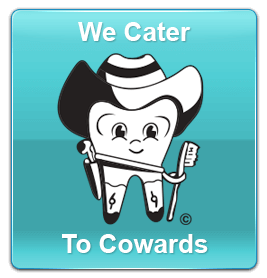Orthodontics
What Is Orthodontics?
Orthodontics is a branch of dentistry where we primarily treat patients with improper positioning of their teeth which results in an improper bite, technically called malocclusion. We also frequently correct undesirable cosmetic effects caused by crowding, twisting, uneven spacing of the teeth, thereby restoring the beautiful smile that properly positioned teeth can mean for our patients.
Who Needs Orthodontics?
Young or old, child or adult — if you think you need orthodontics, you probably do! And, believe it or not, your bite is actually more important than the straightness and aesthetics of your teeth. The way your teeth function (bite) greatly affects the health of your teeth and how long they will last you.
Any kind of crooked, misaligned teeth within an arch and any missing, too-short or too long unevenness between the top and bottom arches results in bad bite. Although not classified as a disease, malocclusion is a variation in the ideal position of teeth that can affect the shape of a person’s face and the appearance of their teeth and smile. It can also affect eating, speech and oral hygiene.
Here are a few examples of what problems we can improve with orthodontics:
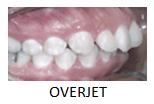
An OVERJET is the most common type of malocclusion and is characterized by the upper front teeth protruding excessively forward of the lower front teeth. Many would describe this as “buck toothed.” The teeth are more susceptible to possible injury from falls, sports, and the like. So in this case, orthodontic treatment improves appearance and protects the teeth.

If your jaw is narrow or too small, there may not be enough space for all the teeth resulting in CROWDING. In this case, one or more teeth may be removed in order to make room for the others. A newer more conservative technique to help crowding is the “slimming” of teeth — a slight “sanding” reduction between nearby teeth.

SPACING is the opposite of crowding. Here there are spaces between your teeth due to missing teeth, small teeth or the teeth simply do not fill up the mouth.
An IMPACTED TOOTH is any tooth that is prevented from reaching its normal position in the mouth by tissue, bone, or another tooth. In our office, we have very successfully coaxed impacted teeth into their proper positions with orthodontics, though sometimes a surgery is usually needed to accomplish this.

ASYMETRICAL TEETH are when your upper and lower teeth do not line up when your mouth is closed and your teeth are showing. We can use orthodontics to slightly shift your teeth into alignment.
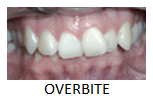
If you have an OVERBITE, the upper front teeth come down too far and cover the lower ones too much when your teeth are clenched. Orthodontics can help us "open” your bite.
If your upper teeth bite inside the lower ones when your teeth are clenched, we say you have a REVERSE BITE. This too is handled with orthodontics.

When you clench your teeth and look in the mirror, if there is space between the edges of your upper front teeth and the edges of your lower front teeth, we say you have an OPEN BITE. A proper bite, and smile for that matter, has the upper front teeth slightly covering the edges of the lower front teeth.
In the case of an UNDERBITE, the upper arch appears pushed back, or the lower arch appears pulled forward. People with an underbite have a more prominent jaw than normal.
A CROSSBITE condition occurs when there are irregularities of the occlusal (biting) surface of your teeth, one or more teeth can tilt toward the cheek or toward the tongue in relation to the tooth above or below it. This kind of malocclusion causes excessive stress on your jaw bone and is mainly due to heredity. Sometimes crossbites are caused by sleep positions or oral habits like finger-sucking.
Orthodontics can also improve your OBSTRUCTED AIRWAY. Many people snore or have sleep apnea. Sometimes the cause is narrow boney arches, usually the upper arch, that contribute to an insufficient airway. If you consider that the oral palate, the roof of your mouth, is actually the bony base of the nose, it makes sense to expand the palate in order to help open your airway.
If you are dealing with malocclusion and a less than desirable smile, orthodontic treatment can mean less embarrassment, more self-esteem and, for many we have seen, a new life!
What Can You Do With Orthodontics?
When Should You Start?

In our office, we routinely monitor our patients for any possible orthodontic needs. Your child’s growth and development can be estimated so that treatment is begun at the best time.
Many children start orthodontics between the ages of 10 and 12 if a bad bite or unaesthetic problem has been diagnosed. In some cases, even earlier treatment is advisable, sometimes as early as age 2 or 3. In this way, later in life, a serious and more complicated problem requiring surgery can be avoided.
Adults can also benefit from braces. Age is usually not a barrier at all. The main difference is that adults are not growing and their mouths must be periodontally healthy before straightening is done, whether with braces or clear aligners.
What Are Braces?
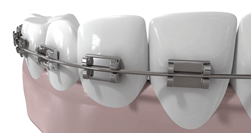
Basically, braces consist of small rectangular cleats, called brackets, that are bonded to your teeth. Each tooth has its own manufactured bracket specific to that tooth. Then, a special flexible wire is threaded through the cleats and tied in place. As the treatment progresses, stiffer wires are used to gently guide your teeth to their most ideal position. Modern materials and advanced techniques make the whole braces experience much more comfortable than in years past. And although the length of treatment varies for each case, the usual time is between 6 and 24 months. During this time, it is important to keep in mind that the goal is to properly align your teeth and jaws in order to produce a correct bite and pleasant smile.
What Are The Benefits Of Traditional Band And Bracket Braces?
Can I Get Invisalign®?
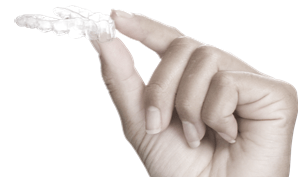
If you have been considering orthodontics, then you most likely have heard about Invisalign®. But do you know that Invisalign is the name of only one of several manufacturers that use similar “clear aligner” systems for orthodontics?
And since expensive mass marketing has almost made Invisalign® a household word, their name-brand product demands a premium price.
Luckily, in the world of invisible aligners, it is the dentist’s knowledge, technique and experience in orthodontics that is paramount. In our office, we use ClearCorrect® invisible aligners for a variety of reasons that we won’t bore you with. Suffice it to say, we have found this system more than adequate in some areas, superior in other ways, yet more affordable for our patients.
This wonderful “aligner” technique will actually straighten your teeth without wires and braces. It involves clear, nearly invisible trays which gradually move your teeth into straighter positions until you have a beautiful smile.
If you are a candidate for this type of orthodontics, we make impressions of your teeth here in our office dental laboratory using 3D computer technology. This creates a series of clear, nearly invisible plastic aligners that are worn consecutively over approximately one year. Some cases can even be done in as little as 6 months. Advanced computer technology is used to fabricate and modify the aligners to the doctor’s prescription, which is based on your specific dental needs. Many adults select this type of treatment in order to avoid the look of traditional braces.
Certain guidelines are used to determine whether or not someone is a candidate for this type of orthodontics, but generally over half of all orthodontic cases can be treated in this manner. Of course, should we find you are not a good candidate for these, we can still accommodate you with traditional braces.
What Are The Benefits Of “Invisible” Aligning Trays?
FAQ About Orthodontic Treatment
How do I brush and floss?
Using an orthodontic toothbrush or a regular soft toothbrush, it is very important to brush your teeth ideally after any meal or snack. In fact, you will probably want to clean them more frequently because food gets stuck in the brackets and wires causing bad breath, tooth decay or enamel stain damage. If you cannot brush immediately after eating, be sure to swish your mouth with water in order to remove as much food as possible until you can brush properly. The important thing is to clean your braces thoroughly of any debris on the brackets and wires. You should also floss at least once per day with a “floss threader” as well as irrigate with a device similar to a Waterpik®. By the way, remember…. do not use a whitening toothpaste! You don’t want two-toned teeth when your braces come off.
How long will it take?
Sorry to say, it all depends on your individual case. The average treatment time is one to two years (12-24 months). And while there are methods for moving teeth faster, the risk of damaging your teeth can be greater.
Will it hurt?
Having the bands and brackets put on doesn’t hurt, but there is some pressure and pain usually for the first few days. Your teeth will feel sore in general and the brackets rubbing on the inside of your lips can cause mouth sores. Within a few weeks, thicker tissue forms inside your mouth and everything settles down. The best way to minimize your discomfort during this period is to use dental wax as needed, rinse with warm salt water several times a day, eat soft foods, chew slowly and use an OTC pain killer as necessary.
What are retainers?
After your braces come off, impressions of your teeth are made and a set of retainers are made. Different types of retainers are available, and are prescribed according to what is best for your mouth. They are designed to keep your teeth in the desired positions we spent the last years getting them to. You will most likely be instructed to wear them only at night when sleeping.
How long will I need to wear a retainer?
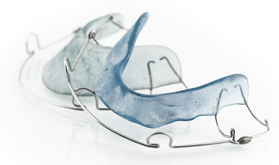
At least to some degree… forever. That’s right, forever. Wearing your retainer ensures that your teeth will not move back into their old unwanted positions. In general, you will need to wear them just enough to keep your teeth where we put them. In the beginning, you might wear them day and night, but as time goes on you may end up wearing them a couple nights each week. If you stop wearing them completely, you are only asking for trouble. Remember, the goal is to keep that new smile of yours!
Am I too old for braces?
Age is rarely a factor. I have done braces for many “senior citizens.” If your mouth is healthy, braces are usually an option.
What Is “Instant Orthodontics”?

What if your orthodontic problem could be corrected in two visits? It really is possible for some patients! Whenever a patient has crooked, stained, chipped or worn teeth, with or without missing teeth, a dental reconstruction can be considered. By placing porcelain crowns or laminates over the poorly positioned teeth, your smile can be brought back to youthful life. We simply improve all aspects of your smile and bite with the crowns instead of with braces — and that is why we call it “instant orthodontics.” Remember, orthodontics alone only straightens your teeth. It does nothing for the color, structure or strength of your teeth.
When indicated, “instant orthodontics” is a great service and it can be completed in as little as two visits!
